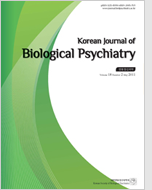
- Past Issues
- e-Submission
-

2021 Impact Factor 1.766
5-Year Impact Factor 1.674
Editorial Office
- +82-01-9989-7744
- kbiolpsychiatry@gmail.com
- https://www.biolpsychiatry.or.kr/

2021 Impact Factor 1.766
5-Year Impact Factor 1.674
Korean Journal of Biological Psychiatry 2016;23(3):108-15. Published online: Mar, 1, 2016
Aggression and aggressive behaviors, often explained as harmful social interaction with the intention of hurting or inflicting damage upon another, have been considered as an adaptive mechanism from the evolutionary psychological point of view. However, various studies on aggression and aggressive behaviors have been done with psychopathological approach as the extreme aggressive behaviors may harm themselves and others at the same time. Recently, researchers have attempted to explain aggression in terms of neurobiological substrates rather than based on traditional psychopathological and/or behavioral concept. In this regard, there have been findings of differences in neurotransmitters and their receptors, and genetic polymorphisms. In this review article, we provide a brief overview of the literature about seven most frequently reported neurotransmitters including neurohormones (serotonin, norepinephrine, dopamine, gamma-aminobutyric acid, nitric oxide, oxytocin and vasopressin) and an associated enzyme (monoamine oxidase A), which are known to be related with aggression and aggressive behaviors.
Keywords Aggression;Aggressive behavior;Neurobiology;Genetic.